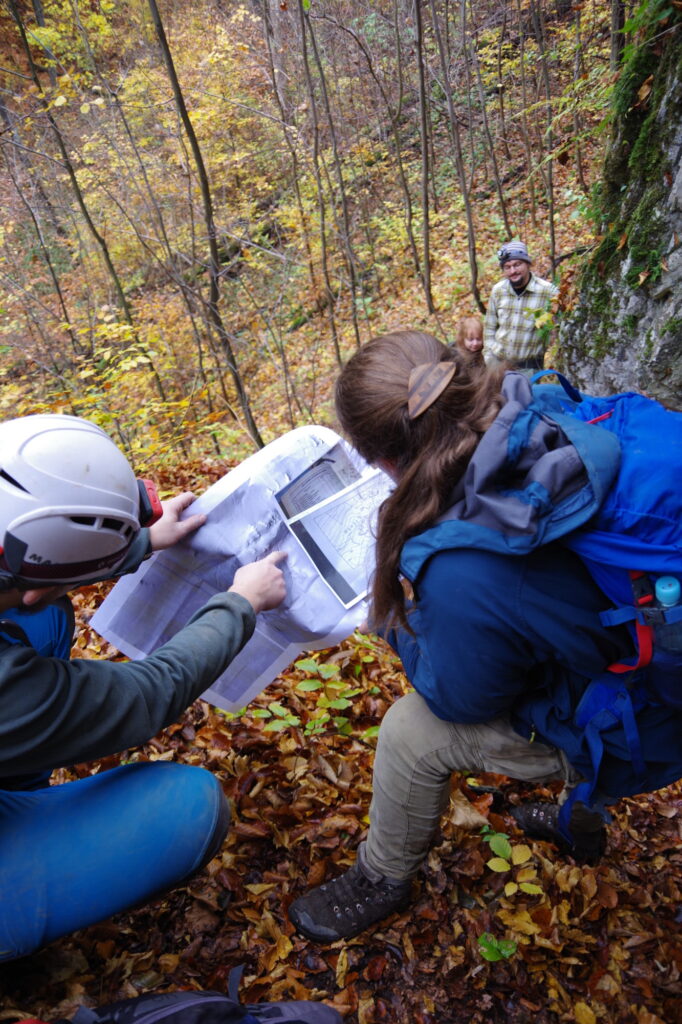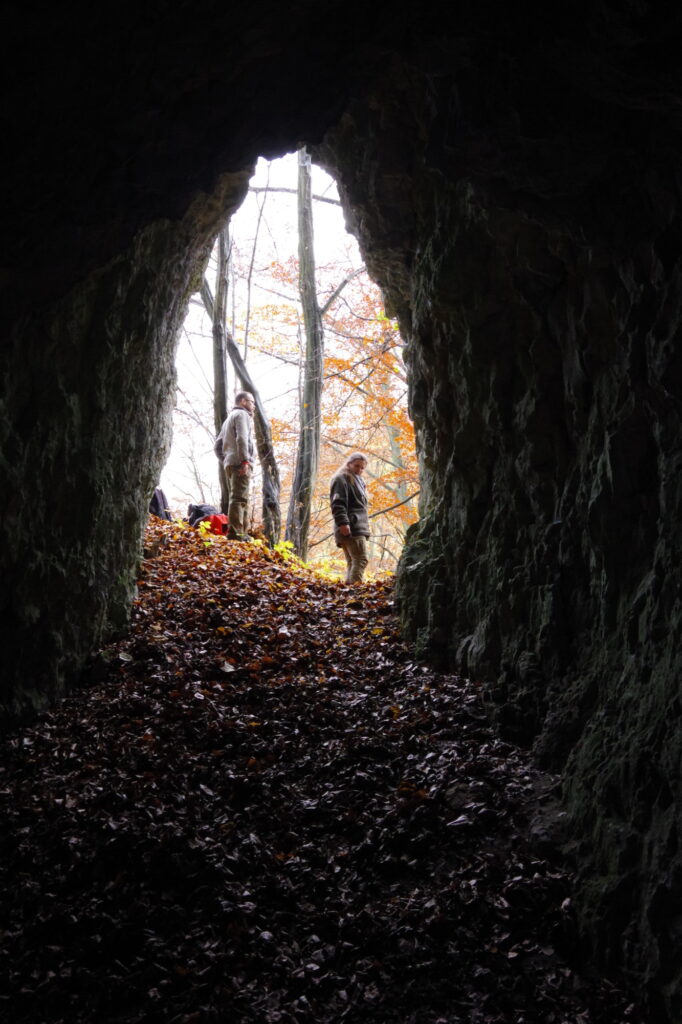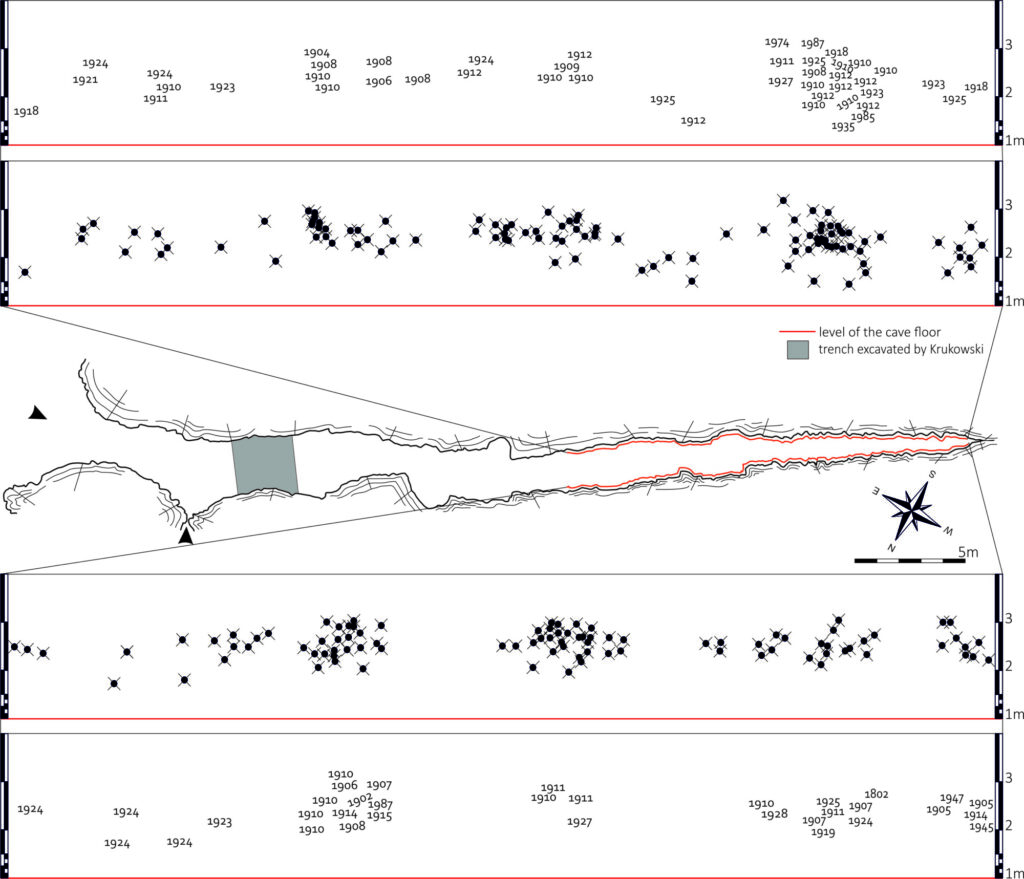
When we were looking for forgotten sites in the Sąspowska Valley, we came across an unexpected discovery which, properly understood, became evidence for the popularity of Ojców as a resort in the 20th century. Here is the story of how an accidental discovery of written messages and graffiti in the walls of Złodziejska Cave made us follow tourists’ traces in caves.

@ M. Bogacki, CC BY-SA 4.0 licence
With a headlight on and a bunch of ziplock bags
When cool autumn days came, the season of excavations in the Ojców National Park (Cracow-Częstochowa Upland) was drawing to a close and it was time for us to explore caves situated in the vicinity of Ojców. Not with a spade and trowel, but with headlights on and ziplock bags ready for collection of artefacts. Our objective was to reach every cave in the Sąspowska Valley that was previously explored by archaeologists. We had no idea that we followed the routes walked by 20th-century tourists.

@ M. Jakubczak, CC BY-SA 4.0 licence
Złodziejska Cave
It was October 2018. We set off from Ojców to Jamki Gully, a part of the Sąspowska Valley. It is a strictly protected area, which did not merely mean we were the only hikers in this part of the park, but we also had to struggle through the freely growing vegetation on the bottom of the gully. One of our destinations was Złodziejska Cave, located at the junction of two gullies – Jamki and Pradła. The cave is situated 25 m above the bottom of Pradła Gully and has two entrances. It is not only easy to see from the gully, but also easy to reach. It forms an elongated tall corridor, clearly tapering towards the end, and is 43 m long. Right behind the main, eastern entrance, there is a side corridor, with the other entrance. In the main corridor there is a depression that is a few metres deep. For many years it was interpreted as left by the sourcing of cave sediments, which were then sold as fertilizer in the 19th century. The sediments, which contained animal bones, guano and other organic materials, were characterized by a high content of phosphorus, hence their value for agriculture. This practice was stopped by archaeologist protests in the first half of the 20th century because the cave sediments also contained many archaeological artefacts. As a consequence of sediment sourcing on an industrial scale, most artefacts were lost forever. However, analysis of documentation conducted by Stefan Krukowski contradicted the theory of natural fertilizer sourcing from Złodziejska Cave. A drawing of the cave map made by Krukowski in 1922, which confirms that he explored the cave, has survived in the Archive of the State Archaeological Museum in Warsaw. Nevertheless, any artefacts that might have been found at that time were lost.

@ M. Leloch, CC BY-SA 4.0 licence
Relics
Let us leave the past archaeological excavations in Złodziejska Cave behind and come back to our expedition. The most exciting thing was still ahead of us. We went past the trench that had not been refilled and walked deeper into the cave along the tapering corridor. Like archaeologists usually do, we were looking down at what was under our feet, we hoped for some discoveries. When we squeezed between the walls, reached the end of the corridor and lifted our heads up, our headlamps lit something surprising. The walls of the corridor were covered with partially worn or unintelligible written messages. They were relics left by the tourists who had been visiting this place for more than 150 years.
Cave tourists
During the work on our project we spent a lot of time studying human activity in caves, we tried to reconstruct the story of the lives of cave dwellers and identify the functions of the caves in everyday lives of their inhabitants. As a result of the discovery in Złodziejska Cave, we became aware of another group of cave users, whose presence is very well visible on tourists routes and in cafés in the area of Ojców, but not necessarily so in archaeological material. Thus we decided to follow tourists’ traces in caves.
We were able to identify 179 written messages on the walls of Złodziejska Cave. They were made with ball-point pens, pencils, sometimes incised with a sharp object. They are simple notes – names (or initials) and surnames, quite often with dates, but rather rarely with the names of towns or villages. The recording and reading of all these messages helped us to establish the time when the cave enjoyed the greatest popularity: 1904-1915. More than a half of the notes came from this period. Many also appeared in 1918-1928. Later on tourists left such relics sporadically. The last “record” comes from 1987.

From Cracow to Ojców along the gully
We found 96 written messages with dates. Although this number might not be impressive, when we compared the frequency of the notes in different periods with the history of the vicinity of Ojców and with changes in the local road network, we managed to collect a consistent story of the past. Early 20th century was the time when the Ojców Spa thrived. It was also a time when Jamki Gully, just below Złodziejska Cave, was the location of the main route from Cracow to Ojców, which changed only in 1928. That was when a new road, running over the Cracow Gate and passing around the gully, was opened. At the same time, the popularity of Ojców decreased. However, a tourist route still followed along Jamki Gully and tourists still went to Złodziejska Cave. After all, it was situated close to Ojców and easy to access. Tourists particularly liked to show up there in summer months. They travelled not only from places located in close proximity, such as Wolbrom or Olkusz, but also from more distant urban centres, e.g. Warsaw or Łódź. The written messages on the walls of the cave stopped appearing in the second half of the 20th century. Ojców National Park was founded in 1956. Since then merely four notes were made, and they were only initials. Three of them appeared after 1984, when Jamki Gully was already a strictly protected area.

Beginnings of conscious tourism?
The practice of writing on the cave walls stopped long before the route along the bottom of the gully was closed. Perhaps then, the walls of Złodziejska Cave are not merely the record of tourist traffic in the area of Ojców, but also evidence for rising awareness and changing practices among tourists.
References:
Author: Natalia Gryczewska
Translation: B.M.
This text was funded by project entitled “From caves to public: A series of popular science articles published on the archeowieści.pl blog, showing a multidisciplinary approach in archaeology, based on the results of our researches in the Ojców Jura” from Inicjatywa Doskonałości – Uczelnia Badawcza programme. Research on the caves of the Sąspowska Valley was funded by the National Science Centre, project: SONATA BIS 2016/22/E/HS3/00486.
